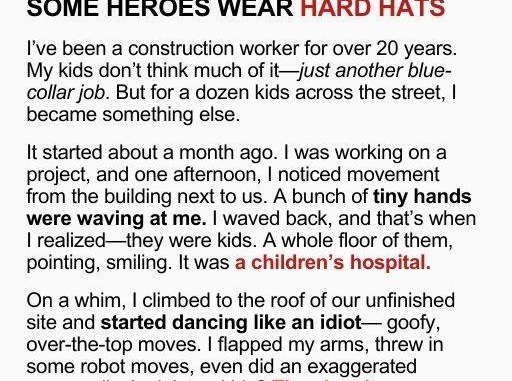
I’ve been in construction for over two decades. It’s honest work—tough, sweaty, and rarely celebrated. My kids see me come home covered in dust and exhaustion, just another man in a hard hat. Nothing remarkable.
But for a group of children in the hospital across the street, I became something more than just a builder.
It began about a month ago when my crew was assigned to a downtown construction project. The building was in its early stages, surrounded by scaffolding. From my spot high up, I could see neighboring buildings. One day during lunch, I noticed someone waving.
At first, I assumed it was a co-worker or someone on the street trying to get my attention. But then I saw them—a group of kids, crowded at the windows of the hospital next door. The moment I looked over, they started waving like crazy. That’s when I realized—they were patients.
I waved back with a chuckle, but something about the joy on their faces made me pause. They weren’t just being friendly. They were looking for something—anything—to break the monotony of hospital life.
That’s when I got an idea.
On a whim, I climbed to the roof and started dancing—ridiculous, over-the-top moves like I used to do for my kids when they were little. I flailed, moonwalked, even attempted a terrible robot dance. And those kids? They lit up. Laughed, clapped, cheered.
From then on, it became a daily ritual. I greeted them every afternoon with a new silly routine. Some of the guys on my team joined in—Tony played air guitar with a broom, Marcos juggled his gloves. What started as a wave became something much bigger.
Suddenly, work wasn’t just work. I looked forward to it. It felt incredible to know we were giving those kids something to smile about.
Then one night at home, another idea came to me.
The next morning, I printed a life-sized cutout of Waldo—yes, the guy from Where’s Waldo?—and hid him somewhere on the site. I made sure he was visible from the hospital, but not too easy to spot. That afternoon, when the kids waved, I pointed in Waldo’s direction and gave a thumbs-up. They eventually spotted him and went nuts with excitement.
The following day, I moved Waldo. And just like that, we had a game.
Each morning, I hid Waldo in a new place—behind scaffolding, dangling from beams, once even strapped to a cement mixer. The kids played along, scanning the site and pointing excitedly when they found him.
It became our thing.
Two weeks later, something unexpected happened. A hospital nurse came to our site. I braced myself, thinking we were in trouble. But instead, she smiled and said the kids wanted to meet us.
I was speechless.
That weekend, a few of us visited the hospital. We brought mini Waldos for the kids to play with. When we walked into the playroom, the kids cheered like we were rock stars.
We spent hours with them—hiding mini Waldos, playing games, talking. Their energy was contagious. Parents approached us, thanking us for bringing light to their children’s days. One mother pulled me aside, teary-eyed.
“You don’t realize what this means,” she said. “My daughter hadn’t been excited about anything in weeks. Now, every morning, she can’t wait to find Waldo.”
I was floored.
I’d always thought of myself as just a guy who builds stuff—nothing glamorous. But that day, I realized I had built something far more meaningful.
A connection. A moment of joy in a place that needed it most.
The next week, I returned to work. The kids were there, waving like always. I waved back—and then picked up a piece of plywood.
I scrawled a message in big, bold letters:
“YOU ARE THE REAL HEROES.”
I held it high for them to see. The kids smiled wide, pressing their hands to the windows. One little boy, bald from treatment, placed his hands over his heart and nodded.
I nodded back.
Being a hero doesn’t always mean wearing a cape. Sometimes, it means dancing on a rooftop, hiding a cardboard cutout, and reminding someone they matter.
If this story warmed your heart, share it. You never know who needs a little joy today.
Leave a Reply